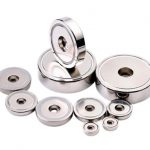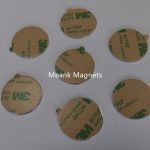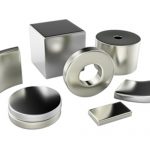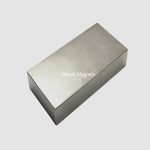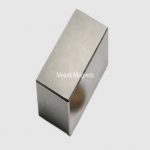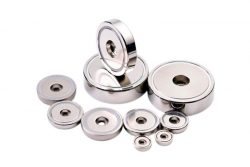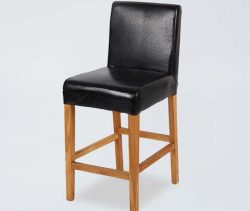FAQ
Can I make a magnet that I already have any stronger?
Once a magnet is fully magnetized, you can not make it any stronger – it is “saturated”. In that sense, magnets are like buckets of water: once they are full, they can’t get any “fuller”
How do you measure the strength of a magnet?
Most commonly, Gaussmeters, Magnetometers, or Pull-Testers are used to measure the strength of a magnet. Gaussmeters measure the strength in Gauss, Magnetometers measure in Gauss or arbitrary units (so it’s easy to compare one magnet to another), and Pull-Testers can measure pull in pounds, kilograms, or other force units. Special Gaussmeters can cost several thousands of dollars. We stock several types of Gaussmeters that cost between $400 and $1,500 each.
What is a permanent magnet?
Modern permanent magnets are made of special alloys that have been found through research to create increasingly better magnets. Permanent magnets have a magnetic field that does not turn on and off like electromagnets. Permanent magnets are often used for motors, generators, televisions, etc. The most common families of magnet materials today are ones made out of Aluminum-Nickel-Cobalt, Strontium-Iron (Ferrites, also known as ceramic), Neodymium-Iron-Boron (sometimes referred to as “strong magnets”), and Samarium Cobalt. The Samarium Cobalt and Neodymium Iron Boron families are collectively known as Rare Earth magnets.
Are neodymium magnets waterproof?
No, they are not waterproof if neodymium magnets are typically coated with nickel, zinc or epoxy to protect them against rust and corrosion from moisture.
Neodymium magnets will work wet or submerged for a short period. Any water penetration into the magnet, however, will cause a slow deterioration of the magnet’s magnetic field and cause rust to leak from even the most microscopic scratch or aberration in the magnet’s outer coating.
If you are looking for waterproof neodymium magnets for super strength, please check out our plastic coated neodymium magnets or rubber coated neodymium magnets. These magnets are encased in a waterproof coating that protects them from moisture.
What are the most common applications of neodymium rare earth magnets
The most common places you’ll find neodymium rare earth magnets include:
• Retail signs and counter displays.
• Trade show booths and staging structures.
• Leather purses, bags, garments, and holsters.
• Custom boxes for premium products.
• Presentation folders and scrapbooks.
• Arts, crafts, and jewelry.
• Wood doors and cabinets as door latches.
• Health bracelets, bandages, and other medical devices.
• Window coverings and blinds.
• Magnetic resonance imaging (MRI) devices.
• Audio speakers.
• Vacuum cleaners and other motorized household appliances.
• Bicycle dynamos.
• Computer hard drives.
• Wind turbine generators.
• Fishing reel brakes.
• Permanent magnet motors in cordless tools.
• High-performance AC servo motors.
• Traction motors.
• Integrated starter-generators in hybrid and electric vehicles.
• Mechanically powered flashlights, which use magnets to generate electricity from a shaking motion.
• Industrial, educational, scientific and testing/quality control applications such as verifying and maintaining product purity and equipment protection and integrity.
• Linear motors used in mag-lev trains and other motorized model equipment.
• Scientific applications such as diamagnetic levitation experimentation, the study of magnetic field dynamics and superconductor levitation.
• Electro-dynamic bearings.
• Roller coaster and other thrill ride technology.
• Magnet toys.
• Electric guitar pickups.
• Miniature figures and models.
How do permanent magnets work?
All permanent magnets work because of their unique atomic structure. Unlike all other objects, the atoms within magnets are all spinning in the same direction. This atomic flow inside of each permanent magnet creates an invisible magnetic force or field around the magnet that can attract or repel other magnets – and attract other metal objects.
In addition, all permanent magnets have a north and south pole on opposite sides of the magnet. The north pole of a magnet points roughly toward earth’s north pole and vice-versa.
In terms of functionality, the common saying is: like poles repel, unlike poles attract.
Why are most neodymium magnets plated or coated?
In order to preserve and protect the lasting performance of each magnet’s magnetic field, most neodymium magnets are plated or coated.Neodymium magnets are mainly composed of neodymium, iron, and boron. If they are not plated, the iron in the material will oxidize, particularly if exposed to moisture. Even normal humidity will rust any iron over time.
Nickel is the most common choice, as it is durable and cost-effective. All our neodymium magnets are coated with a triple layers of nickel/copper/nickel. This creates a shiny silver finish and provides dependable resistance to corrosion in most applications.
If you are interested in different coating options, contact us for more information on coating.
Why are neodymium magnets considered to be the strongest magnets on earth?
Developed by physicists during the 1970s, neodymium magnets are considered to be the strongest permanent magnets in existence. This is because they create the highest magnetic field per size and volume of any other known natural or manufactured material.
The magnetic field typically produced by rare earth neodymium magnets can be in excess of 1.4 Teslas, whereas all other magnets normally generate fields of 0.5 to 1 Tesla.
And not only are neodymium magnets the most powerful magnets on the planet, they are also the most affordable type of rare earth magnet available today.
What does the N rating on neodymium magnets mean?
The magnet grade or N rating refers to the Maximum Energy Product of the material that the magnet is made from and it refers to the maximum strength that the material can be magnetized to permanently hold.
Generally speaking, neodymium magnets range from the grade of N35 to N52. The higher the grade number, the incrementally stronger the magnet will be.
The highest grades of neodymium magnets that we normally carry is N52 neodymium magnet, a rating that is generally measured in Tesla metrics or units of Gauss Oersted (MGOe).
A magnet of grade N42 has a Maximum Energy Product of Gauss 42 MGOe, while an N52, at 52 MGOe would be incrementally stronger.
Will neodymium magnets lose their strength over time?
Very little. If they are properly handled, which includes not overheated or physically damaged, our neodymium magnets will lose less than 1 percent of their strength over 10 years. This is not enough to notice without very sensitive measuring equipment. In addition, the neodymium magnets we offer will not lose their strength even if they are held in repelling or attracting positions with other magnets over long periods of time.
Will stacking magnets together make them stronger?
Yes, stacking multiple magnets together can make them stronger. Two or more magnets stacked together will exhibit nearly the same strength as a single magnet of the combined size. For example, if you stacked two 1/2 x 1/4 inch thick disc magnets to make a 1/2 x 1/2 inch combined size, the two magnets would have nearly same strength as a single 1/2 x 1/2 inch magnet.
How do magnetic flux lines behave?
The general answer is “Predictably”! Magnetic lines are three-dimensional, surrounding a bar magnet on all sides.
Likepoles repel and unlike poles attract. When opposite poles of two magnets are brought together, the magnetic force lines join up and the two magnets pull together.
When like poles of two magnets are brought together, the magnetic force lines push away from each other and the two magnets repel each other.
What is pot magnet?
A pot magnet comes from the structure of a magnet assembly, a permanent magnet housed with a steel shell is called a pot magnet(also known as cup magnets and mounting magnets, only one magnetic surface used.
Which kinds of permanent magnets can be used for pot magnets?
All the neodymium, Samarium-Cobalt, ferrite, and AlNiCo magnets can be used to make pot magnets, but the most widely used types are neodymium pot magnets and ferrite pot magnets.
What functions does the iron shell have on the pot magnet?
The iron shell from a pot magnet has three main functions:
It protects the magnet.
It guides the magnetic line and enlarges the magnetic force.
It’s easy to weld fastening parts (for example internal & external threaded stud) on it.
What are the advantages of rubber coated pot magnet compared with ordinary iron shell covered pot magnet?
Rubber-coated pot magnets have better waterproof and corrosion resistance ability than iron-shell pot magnets.
The contact surface can be protected by using rubber-coated pot magnets.
How to maintain fishing magnets?
Wipe it clean immediately after use and let it dry as soon as possible, then seal it and store it in a dry and safe environment. Do not place fishing magnets where there is dust.
How to test the magnetic force of a fishing magnet?
With the special pull force testing equipment, at room temperature, the products are adsorbed on the smooth iron plate of 10 mm thickness, and the powerful fishing magnets are pulled upward at a uniform speed.
What is the maximum working temperature of NdFeB pot magnet?
The maximum working temperature of the NdFeB pot magnet depends on the brand of NdFeB magnet used, the highest working temperature of the common NdFeB pot magnet is only 80℃, but the maximum working temperature can reach 200℃.
How to make full use of the pull force of a cup magnet?
Let the direction of pulling force perpendicular to the working face of the cup magnet, the pulling force can reach the maximum.
Which factors will affect the force testing results of cup magnets?
Thickness and surface flatness of the adsorbed object.
Whether the magnet is in full contact with the adsorbed object.
The pulling speed or angle.
Under what conditions is the magnetic pull force of a cup magnet maximized?
When the direction of pulling force is perpendicular to the working face of the magnet, the pulling force of the cup magnet can reach the maximum.
What’s the use of cup magnets?
Cup magnets are can be used to provide magnetic clamping solution, magnetic mounting solution, magnetic hanging solution, magnetic holding solution, magnetic salvaging solution, etc.
What is clamping magnet?
A clamping magnet is a magnetic assembly that used to clamp & hold objects, such as magnetic name badges, push pin magnets, memo magnet, some NdFeB cup magnets and Ferrite cup magnets also used as clamping magnets.
What are mounting magnets?
The magnetic assemblies used for mounting are known as mounting magnets, including neodymium mounting magnets and ferrite mounting magnets. Mounting magnets are usually with mounting holes or screwed mounting bush & threaded stem.
How can you know which is the North Pole of a magnet?
We can’t know by looking. We can tell you by placing a compass close to the magnet. The end of the needle that normally points toward the North Pole of the Earth would point to the South Pole of the magnet.
What are Magnetic Poles?
The surfaces from which the invisible lines of magnetic flux emanate and connect on return to the magnet are called magnetic poles.
Can magnets that have lost magnetism be re-magnetized?
Provided that the material has not been damaged by extreme heat, magnets can be re-magnetized back to original strength, if they have been exposed to conditions which cause them to become demagnetized.
What are Rare Earth Magnets?
The magnets that are made of the Rare Earth group of elements are known as rare earth magnets.Neodymium-Iron-Boron and Samarium-Cobalt magnets are the most common rare earth magnets.
What does magnetic pull force mean?
Every neodymium magnet has a pull force, which tells you exactly how powerful the magnet is. Magnetic pull force is measured in pounds or kilograms, the pull force is the force needed to pull that magnet straight free from a 1/8 inch (3.175 mm) thick steel plate. The pull force also tells you the limit on the holding power of the magnet.
Generally, any magnet with a magnetic pull force above seven pounds (3.175 kg) can pinch your fingers. Strong neodymium magnets can be even more dangerous and should only be handled by experienced individuals.
How are finished neodymium magnets made?
Neodymium magnets, also known as NIB or NdFeB magnets, are comprised of neodymium, iron, and boron compound referred to as Nd2Fe14B.
This compound is a powdered mixture. It is first poured, then pressed (using extreme pressure) into specially-cast molds. The compound is then sintered (heated under a vacuum), cooled, then ground or sliced into the desired shape. It’s not finished neodymium magnet until this step.
Next, the magnets are dipped in a specified coating material such as zinc, gold, or triple-layer nickel/copper/nickel alloy plating. Now it is finished with neodymium magnets
Finally, the finished magnets are magnetized by exposing them to an extremely strong magnetic field. This final step is what turns neodymium magnets into permanent magnets, enabling them to perpetually produce their powerful magnetic pull or repel strength.
What are neodymium magnets?
Neodymium rare earth magnets are made with neodymium, iron, and boron. They are up to 10 times stronger than all other ferrite, ceramic, or alnico magnets of equal size. They are considered to be the strongest magnets on earth.
What does “magnetized through thickness” mean?
We use the description “magnetized through thickness” to identify the locations of the poles on block magnets. Thickness is always the last listed dimension and is also usually the smallest size.
For most of thickness magnetized block magnets, it’s means that the magnets stick or repel in the middle, on the large flat surfaces, rather than at the end of the block.
Are the countersunk and self-adhesive magnets paired equally north/south magnetized?
Most of our countersunk and self adhesive magnets come in equally paired magnetized, which enable you to use them as attachments to other magnets if desired.
For pairing with steel discs or other plates, the north/south orientation of the countersunk hole or adhesive tape is not an issue as both the north and south poles will be equally attracted to steel surfaces.
What does
That means that the poles of the magnet will be on the large flat surfaces of disc and cylinder magnets rather than the side. Most of our round disc magnets and rare earth cylinder magnets are labelled as axially magnetized because the magnetization direction is through the axis of the magnet.
What materials do neodymium magnets attract?
Neodymium magnets only attract ferromagnetic materials. The most commonly available and attracted elements are iron (Fe), nickel (Ni), and cobalt (Co). Steel is also very susceptible or attracted to a magnetic field because it is ferromagnetic as an alloy of iron and other metals.
Is one pole of a magnet stronger than the other pole?
No, both poles of a magnet have the same magnetic strength.
How to correctly use self-adhesive magnets?
Self-adhesive magnets enable you to attach the magnet to a non-magnetic surface, such as aluminum, wood, plastic, ceramic, rubber, paper, and other non-ferrous materials.
Normally, self-adhesive magnets come in packs with half self-adhesive on the north side, and half with the self adhesive on the south side. This enables them to attract if needed to form a closure or fastener.
We have foam adhesive magnets for sale. This high-performance adhesive delivers excellent shear strength to resist slippage and edge-lifting.
Simply peel the paper off the adhesive and stick it in position. You can quickly re-adjust it because the strong adhesive is temporarily repositionable. This helps you accurately adjust and position the magnet to your exact specifications.
Once the magnet is in position, press firmly so that the underside adheres evenly. We recommend that you let the adhesive cure for 24 – 48 hours before putting any stress on the bond.
What does “magnetic orientation direction” mean?
Most modern magnet materials have a “grain” in that they can be magnetized for maximum effect only through one direction. This is the “orientation direction”, also known as the “easy axis”, or “axis”
Un-oriented magnets (also known as “Isotropic magnets”) are much weaker than oriented magnets, and can be magnetized in any direction. Oriented magnets (also known as “Anisotropic magnets”) are not the same in every direction – they have a preferred direction in which they should be magnetized.
What are magnetic assemblies?
Magnetic assemblies consists of one or more magnets, and other components, such as steel, that generally affect the functioning of the magnet.Pot magnets,hook magnets,channel magnets and rubber coated mounting magnets are magnetic assemblies.

